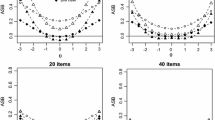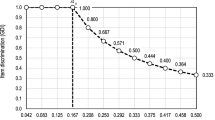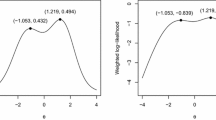Abstract
Information functions are used to find the optimum ability levels and maximum contributions to information for estimating item parameters in three commonly used logistic item response models. For the three and two parameter logistic models, examinees who contribute maximally to the estimation of item difficulty contribute little to the estimation of item discrimination. This suggests that in applications that depend heavily upon the veracity of individual item parameter estimates (e.g. adaptive testing or text construction), better item calibration results may be obtained (for fixed sample sizes) from examinee calibration samples in which ability is widely dispersed.
Similar content being viewed by others
References
Cook, L. L., Petersen, N. L., & Stocking, M. L. (1983). IRT versus conventional equating methods: A comparative study of scale stability.Journal of Educational Statistics, 8, 136–156.
Cox, D. R. (1970).The analysis of binary data. London: Methuen.
Kendall, M., & Stuart, A. (1979).The advanced theory of statistics. Volume 2. Inference and Relationship. New York: Macmillan.
Lord, F. M. (1968). An analysis of the Verbal Scholastic Aptitude Test using Birnbaum's three-parameter logistic model.Educational and Psychological Measurement, 28, 989–1020.
Lord, F. M. (1980).Applications of item response theory to practical testing problems. Hillsdale, NJ: Erlbaum.
Lord, F. M., & Wingersky, M. S. (1985). Sampling variances and covariances of parameter estimates in item response theory. In D. J. Weiss (Ed.),Proceedings of the 1982 IRT/CAT Conference (pp. 69–88). Minneapolis, MN: University of Minnesota, Department of Psychology, CAT Laboratory.
Mislevy, R. J., & Sheehan, K. M. (1988).The information matrix in latent variable models (Research Report 88Y2-24). Princeton, NJ: Educational Testing Service.
Stocking, M. L. (1988).Scale drift in on-line calibration (Report 88-28). Princeton, NJ: Educational Testing Service.
Thissen, D., & Wainer, H. (1982). Some standard errors in item response theory.Psychometrika, 47, 397–412.
Wingersky, M. S., & Lord, F. M. (1984). An investigation of methods for reducing sampling error in certain IRT procedures.Applied Psychological Measurement, 8, 347–364.
van der Linden, W. J., & Boekkooi-Timminga, E. (1989). A maximin model for test design with practical constraints.Psychometrika, 54, 237–247.
Author information
Authors and Affiliations
Additional information
This work was supported by Contract No. N00014-83-C-0457, project designation NR 150-520, from Cognitive Science Program, Cognitive and Neural Sciences Division, Office of Naval Research and Educational Testing Service through the Program Research Planning Council. Reproduction in whole or in part is permitted for any purpose of the United States Government. The author wishes to acknowledge the invaluable assistance of Maxine B. Kingston in carrying out this study, and to thank Charles Lewis for his many insightful comments on earlier drafts of this paper.
Rights and permissions
About this article
Cite this article
Stocking, M.L. Specifying optimum examinees for item parameter estimation in item response theory. Psychometrika 55, 461–475 (1990). https://doi.org/10.1007/BF02294761
Received:
Revised:
Issue Date:
DOI: https://doi.org/10.1007/BF02294761




